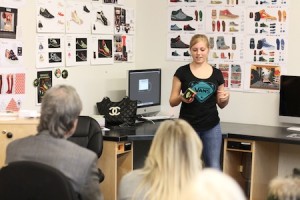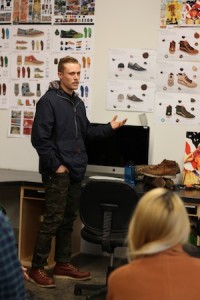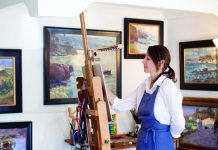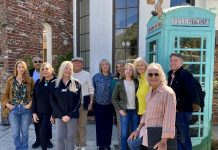
They’ve made the shoes of choice for boaters, skateboarders and BMXers since the 1960s. Sturdy, with skid-resistant soles and padding where it counts, Vans still come in basic colors or plain white. Laced or as slip-ons, these classic canvas treads became a mainstay of the region’s action sports culture.
But the brand that became a hot fad of the ‘80s fell prey to foreign competition a decade later. Since reorganized, a new generation of executives hit the road, prowling for design talent throughout West Coast art schools.
Last week, 10 Vans representatives heard pitches about how to broaden their brand’s appeal without losing its integrity from 13 graphic design students enrolled in a lab concentrating on action sports footwear and apparel at Laguna College of Art and Design.
They got a close look at how student design hopefuls interpreted the shoe for future generations. For students, even more was on the line. All 13 were vying for a coveted summer internship at Van’s Cypress headquarters.
Mark Haskins and Dave Solomon, director and vice president of footwear and equipment, respectively, as well as footwear designer Jon Warren and recruiter Lisa Markham judged students’ presentations on originality but also evaluated suggested manufacturing processes, durability and mass appeal.
“Remember you are not designing for yourself, but a wide segment of the public,” said Haskins during student Marc Sharman’s pitch, centered on an elegantly sleek line of men’s shoes and ladies Vans on high wedge soles.
Conceived by the college’s graphic design department chair, Catharin Eure, this year’s project was executed by individuals rather than the three-student teams in last year’s collaboration with Nike.
The Vans assignment included researching footwear developing methods, company history, mass marketing and merchandizing presentations in varied settings.
As the project’s finale, students presented lines of footwear with all the collateral trimmings: promotional materials, boxes, price, product tags and, in some instances, accompanying apparel.
Renee Granillo, for example, showed a line of embroidered high-tops for women and kids and a more subdued one for men based on Russian folk art. Her promotional materials featured images of the iconic nesting Matryoska dolls.
Chris Summers drew inspiration from his Boy Scout days. Ever prepared, he pitched a family line of shoes made from wool and other materials that could stand up to anything nature might dish out.
Heidi Ruff, a skater fittingly attired in a Vans t-shirt, presented shoes made of breathable nylon “for daredevils prone to skate in storms,” but also presented #5, a pair of quilted, Chanel-inspired high-tops.

Katharine Elliot created a “Little Buccaneer” line for girls and boys and adult lines incorporating black and white Japanese forms. Vans reps praised her “out of the box” thinking when she showed a rare video of roller-bladers performing skateboarders’ stunts.
Amber Jepsen created chameleon shoes, including ballerina flats for women, that could change colors and patterns. An apparent marketing prodigy, she fabricated a “Vans Off The Wall” Monopoly game based on the real thing and gave it to the reps to take back to headquarters.
During last year’s project, Jepsen and two teammates envisioned jerseys for competitive surfers that, through a wireless system, could change colors coded to their standing in a competition. She won the coveted Nike internship in Portland, Ore., last summer and hopes that lighting will strike again with Vans.
“Last year, I was able to learn problem solving from experienced designers who pushed me out of my comfort zone by teaching me how to design for people and their needs. Next, I am hoping to continue learning from different approaches in another setting,” she said.
Her former teammate Emily Arnaut presented vintage inspired footwear and seasonal holiday packaging this year.
While the project provided students with a real-world brand-marketing laboratory, Nicole Galluci, Vans’ human resources representative, assessed students’ own marketability in a competitive labor market.
“Being in a class like this gives design students an edge on their resumé and a better chance of getting an entry-level position, if one’s available,” she said. “While networking is important, we don’t pay all that much attention to students resumes. Portfolios are what we look at closely.”
Photos by Edgar Obrand




